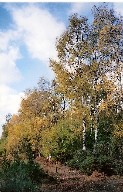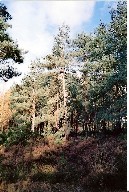| |
 
THE ROYAL
FOREST OF WOOLMER
 |
|
In the Dark Ages
much of the south of England – that
broad tract of land between the North and
the South Downs – was dense
woodland. Anderida’s Wood, known as
The Weald, was described by the Venerable
Bede as thick and inaccessible, the haunt
of wolves, swine and deer. Part of this
was called Wulfmere, the Lake of the
Wolves.
With the coming of the Normans much of
the woodland and associated scrub became
Royal Forests. The Domesday Book lists
twenty-five, of which the New Forest must
be the best known. But there were two
even closer to home: the Royal Forest of
Woolmeer (Woolmer) and the adjoining
Alice Holt Forest. |
Geologically they are quite
different: Alice Holt stands on thick Gault clay,
and hardwoods regenerate easily, whereas Woolmer
lies on beds of the Lower Greensand, where
regeneration is virtually impossible. In fact for
a thousand years Wolmer Forest has been a mixture
of rolling hills, heather covered heathland and
low lying bogs.
In the Middle Ages the combined forests stretched
from Alton to Rogate and beyond, and came under
the wardenship of the manor of East Worldham,
where King John stayed whilst hunting wild boar.
Kings may not have hunted in every forest, but
they guarded their rights zealously, and 1278
Edward I ordered Adam Gordon to take all those
indicted of trespass at Woolmer to be held safely
until otherwise ordered.
In 1578 the last of Woolmer Forest’s native
trees, at Linchborough, were felled “by
persons unknown.” In addition to the poor
soil, regeneration was hampered by exploitation
of the forest for grazing and by turf cutting. In
one year, 1782, three hundred and twenty-five
loads of peat and 340,000 turfs were taken,
resulting in the enlargement of the forest’s
most distinctive feature today, Woolmer Pond. At
about the same time Alice Holt, where nearly
40,000 mature oaks were standing in 1783, up to a
thousand loads of timber were felled each year
for the use of the navy.
  
The only trees which grow
prolifically on the Greensand are Birch and Scots
Pine. In 1789 Gilbert White had complained that
The Royal Forest of Woolmer consisted entirely of
sand covered with heath and fern, without one
standing tree. He must have missed the majestic
oak that still stands close to the River Wey at
Lindford. The great naturalist was also appalled
by the stagnant waters and bogs which abounded
with what he called subterraneous trees.
Following the planting of 1400 acres of Scots
Pine in 1808, William Cobbett wrote in his Rural
Rides “What they can plant the fir for, God
only knows, seeing that the country is already
overstocked with the rubbish.”
Woolmer was finally enclosed in 1864, and passed
into the hands of the Crown Office for Woods
(later the Forestry Commission), who leased the
land to the War Office. Military occupation has
prevented conversion to agriculture, so that
today the bogs and heaths form one of
Britain’s richest heathland wildlife
reserves. It is, for example, the only site in
England where all twelve native amphibians and
reptiles can be found together, including the
rare smooth snake and the Natterjack Toad.
The area near the Pond is well-known to
bird-watchers, and over 130 different species
have been recorded. It is quite possible to see
rarities such as the dashing little hobby hawking
dragonflies in summer, or the great grey shrike
during the winter. In addition there are over 500
species of wild plants and eighty different
fungi.
The Ministry of Defence’s own Conservation
Group co-operates closely with Hampshire County
Council, the Forestry Commission, English Nature
and other bodies in managing the area. It is a
Grade 1 Site of Special Scientific Interest, and
there is limited public access at times when no
firing is taking place on the ranges. Yet how
many of us know that such a valuable resource,
with such a long history, stands on our very
doorstep?
Tom Muckley, February 2006
This article was originally
published by the
Petersfield Post
tommuckley.co.uk
|
|





